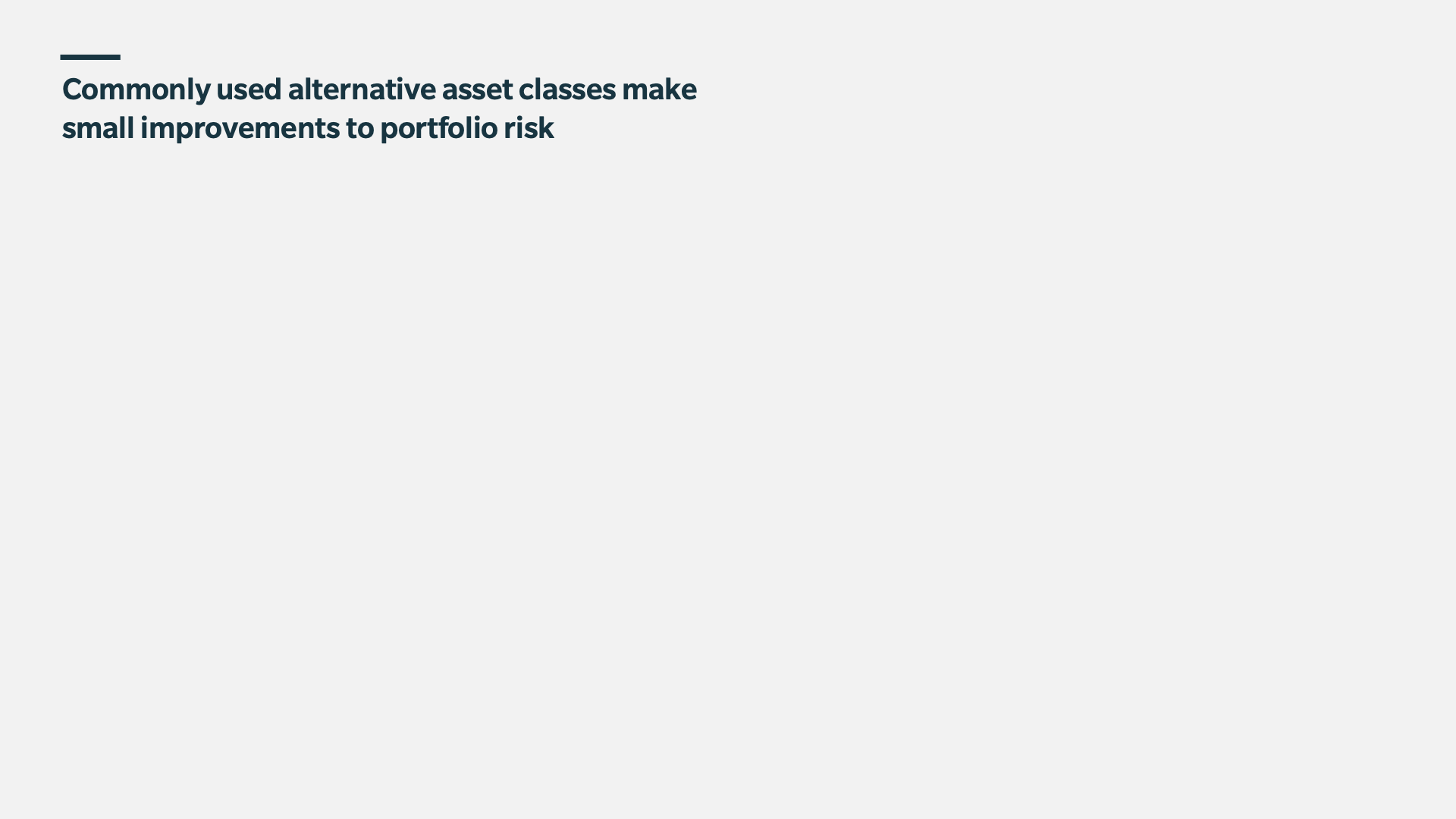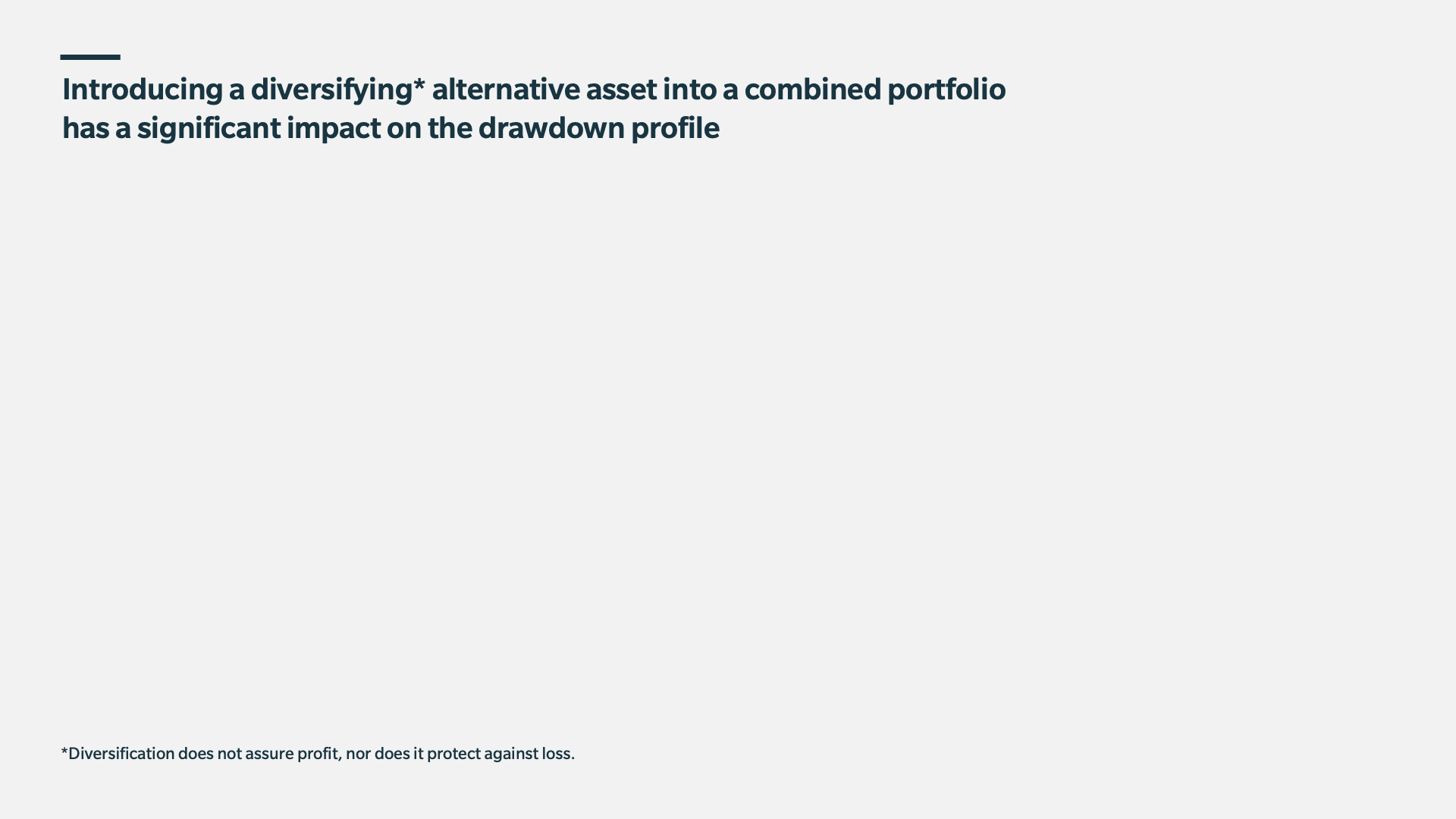When it comes to building portfolios, investors regularly hear about the importance of diversification*.
The basic principle is simple; by investing in a single asset, an investor is fully exposed to its individual risks.
By combining assets with different risk characteristics, it’s generally agreed an investor may be able to improve the risk and return profile of the overall portfolio*.
Potentially, this could mean lower volatility, smaller drawdowns and better compounded returns.
*Diversification does not assure profit, nor does it protect against loss.
Sample Return Series The return series shown are for illustrative purposes, and do not represent returns for Abbey Capital or any of the funds it manages.
The return series shown are for illustrative purposes, and do not represent returns for Abbey Capital or any of the funds it manages.
Before we discuss ‘how’ diversification works, let’s explore ‘why’ diversification has long been a focus for investors and financial advisors. The answer lies in the way portfolio diversification has traditionally been approached.
Diversification – Equity / Bond Correlation
For most of the previous two decades, equity and bond markets have proved to be excellent portfolio companions. In any year where one experienced a negative outcome, the other provided a positive offset.
This period was notable for historically low interest rates, where the negative correlation between equities and bonds was only ever broken for very short periods.
That pattern has changed dramatically in this decade, as inflation has driven a major shift in global interest rate policy, and a persistent positive equity-bond correlation has emerged.
Annual Returns for Equities and Bonds: 2000 to 2023 Source: Abbey Capital, Bloomberg. Equities are represented by the S&P 500 TR Index. Bonds are represented by the JP Morgan US Government Bond Index. Data is shown from 2000 to 2023 for illustrative purposes. The indices referred to herein are not based on the entire population of equities or bonds and are not indicative of the performance of any particular manager or fund. Furthermore, these indices may not be directly comparable. As a result, there are inherent limitations with using these indices for representative purposes and the above is shown for illustrative purposes only. No fund managed by Abbey Capital is benchmarked against any index, including the indices referenced. For an explanation of all indices referenced please go to the appendix.
Source: Abbey Capital, Bloomberg. Equities are represented by the S&P 500 TR Index. Bonds are represented by the JP Morgan US Government Bond Index. Data is shown from 2000 to 2023 for illustrative purposes. The indices referred to herein are not based on the entire population of equities or bonds and are not indicative of the performance of any particular manager or fund. Furthermore, these indices may not be directly comparable. As a result, there are inherent limitations with using these indices for representative purposes and the above is shown for illustrative purposes only. No fund managed by Abbey Capital is benchmarked against any index, including the indices referenced. For an explanation of all indices referenced please go to the appendix.
We believe this change matters.
If a positive correlation between equities and bonds continues, it suggests they are more likely to make and lose money at the same time. This poses a real dilemma for investors, who have often relied on a negative equity-bond correlation to diversify portfolios.
Diversification – Why drawdowns matter
So why might smaller drawdowns and lower volatility be so important in managing portfolios?
The simple answer relates to capital preservation and drawdowns. And, more specifically, the reality of what it actually takes to recover from a drawdown.
An investor might consider the following:
Firstly, the size of return needed for drawdown recovery, and how it’s impacted by compounding.
Sample drawdowns, with return required to exit drawdown This example is shown for illustrative purposes and is not based on the historical or expected drawdown profiles or returns of any asset or index. Results are purely hypothetical there was no actual trading or actual profits for these scenarios. No representation is being made that any account will or is likely to achieve profits or losses similar to these being shown. Please see the hypothetical performance disclaimer below for additional information.
This example is shown for illustrative purposes and is not based on the historical or expected drawdown profiles or returns of any asset or index. Results are purely hypothetical there was no actual trading or actual profits for these scenarios. No representation is being made that any account will or is likely to achieve profits or losses similar to these being shown. Please see the hypothetical performance disclaimer below for additional information.
For example, if a portfolio loses -10% having started with 100 USD, it needs a return of +11.1% on the remaining 90 USD to return to flat. This is compounding in action. To get back to the same number of dollars the portfolio started with, the percentage rate of return needed to exit a drawdown is larger than the drawdown itself.
The problem gets progressively worse as the size of the drawdown increases. Clearing a -20% drawdown requires a return of +25%, while a -50% drawdown means the returns need to make +100%, to get back to where the portfolio began.
Compounding may also affect the time it takes to recover from a drawdown.
The graph below shows how various sizes of drawdown, and subsequent recovery, might look for a portfolio that annualises at +8% return after its initial drawdown. As the starting drawdown becomes larger, it takes longer and longer to recover.
Sample drawdowns and the time required exit, assuming a 5% p.a. return This example is shown for illustrative purposes and is not based on the historical or expected drawdown profiles or returns of any asset or index. Results are purely hypothetical there was no actual trading or actual profits for these scenarios. No representation is being made that any account will or is likely to achieve profits or losses similar to these being shown. Please see the hypothetical performance disclaimer below for additional information.
This example is shown for illustrative purposes and is not based on the historical or expected drawdown profiles or returns of any asset or index. Results are purely hypothetical there was no actual trading or actual profits for these scenarios. No representation is being made that any account will or is likely to achieve profits or losses similar to these being shown. Please see the hypothetical performance disclaimer below for additional information.
It is important to remember that typically investors don’t pay fees to have the value of their portfolios remain flat. They want a positive return on their investment.
Even if an investor demands a modest +5% annualised return, keeping pace can quickly become challenging.
As return expectations continue to compound year-on-year, so too does the time taken to chase down a target return. As we see, the challenge is enlarged by each increase in the size of initial drawdown. In risk management terms, this highlights the positive impact that limiting drawdowns and capital preservation can have in helping investors and financial advisors achieve their long-term investment goals.
So, what can investors do to minimise these types of risk? Focus on diversification*.
When assessing portfolio diversifiers, it’s important to ask some key questions about the assets being considered:
– What are their fundamental return drivers?
– Are these drivers likely to be different to those of equity and bond markets, particularly during periods of market stress?
*Diversification does not assure profit, nor does it protect against loss.
Effective diversification – understanding the asset mix
Understanding correlation is key to understanding diversification. Consider the following example:
The below chart shows the drawdown profile for US equities and a commonly used alternative asset class (which we will call Alt Strategy A) which has a +0.7 correlation to equities. The paths are sometimes different, but often very alike, indicating that they may be influenced by similar return drivers.
This is especially true during larger market corrections. When combined in an equal weighted portfolio, the improvement in portfolio risk (or max drawdown) is relatively small.
Drawdown profile for Equities and Alt Strategy A: January 2000 to April 2024
 Source: Abbey Capital, Bloomberg. Equities are represented by the S&P 500 TR Index. This example is shown for illustrative purposes and is not based on the historical or expected drawdown profiles or returns of any asset or index. Results are purely hypothetical there was no actual trading or actual profits for these scenarios. No representation is being made that any account will or is likely to achieve profits or losses similar to these being shown. Please see the hypothetical performance disclaimer below for additional information.
Source: Abbey Capital, Bloomberg. Equities are represented by the S&P 500 TR Index. This example is shown for illustrative purposes and is not based on the historical or expected drawdown profiles or returns of any asset or index. Results are purely hypothetical there was no actual trading or actual profits for these scenarios. No representation is being made that any account will or is likely to achieve profits or losses similar to these being shown. Please see the hypothetical performance disclaimer below for additional information.
Now, compare this to a different scenario, where Alt Strategy A is replaced by a different alternative asset, which we call Alt Strategy B. The new strategy has exactly the same volatility as Alt Strategy A, but this time Alt Strategy B has a -0.1 correlation to equities instead of +0.7.
Immediately we see the paths of equities and Alt Strategy B are often different, and the impact on the drawdown profile of the combined equal weighted portfolio is significant. Its path is smoother and drawdowns shallower.
Drawdown profile for Equities and Alt Strategy B strategy: January 2000 to April 2024
 Source: Abbey Capital, Bloomberg. Equities are represented by the S&P 500 TR Index. This example is shown for illustrative purposes and is not based on the historical or expected drawdown profiles or returns of any asset or index. Results are purely hypothetical there was no actual trading or actual profits for these scenarios. No representation is being made that any account will or is likely to achieve profits or losses similar to these being shown. Please see the hypothetical performance disclaimer below for additional information.
Source: Abbey Capital, Bloomberg. Equities are represented by the S&P 500 TR Index. This example is shown for illustrative purposes and is not based on the historical or expected drawdown profiles or returns of any asset or index. Results are purely hypothetical there was no actual trading or actual profits for these scenarios. No representation is being made that any account will or is likely to achieve profits or losses similar to these being shown. Please see the hypothetical performance disclaimer below for additional information.
Diversification can reduce the size and length of portfolio drawdowns*. It can also enhance a portfolio’s risk and return characteristics by reducing volatility and improving Sharpe ratio.
It’s not always possible for investors and advisors to know when they or their clients will need liquidity. Liquidity needs are driven by factors that are many and varied, both personal and portfolio related.
By focusing on underlying return drivers when assessing potential diversifiers, investors may better understand their correlation profile, potentially unlocking a valuable portfolio management tool. As our comparison suggests, a well-diversified portfolio can produce a smoother path and reduce the risk of being in a larger drawdown at exactly the time when that liquidity might be needed*.
In portfolio management, it highlights how the journey is just as important as the destination.
*Diversification does not assure profit, nor does it protect against loss.
Indices
S&P 500 Index (Start Date: Mar-1957)
Standard and Poor’s 500 Index is a capitalization-weighted index of 500 stocks. The index is designed to measure performance of the broad domestic economy through changes in its aggregate market value
S&P 500 Index Total Return Index (“S&P 500 TR Index”) (Start Date: Dec-1985)
The S&P 500 Index is an index of 500 US stocks chosen for market size, liquidity and industry grouping, among other factors. The S&P 500 Total Return Index is the total return version of the S&P 500 Index. Dividends are reinvested on a daily basis and all regular cash dividends are assumed reinvested in the index on the ex-date.
JP Morgan US Government Bond Index (Start Date: Jan-1988)
The JP Morgan US Government Index is a leading measure of US government bond market performance. The Index measures the total return of US Treasury securities across the whole yield curve
Definitions
Correlation
Correlation is a statistical measure which quantifies the extent to which two assets, or securities, move in relation to each other. The correlation coefficient between two assets can vary from between -1 and +1, with a positive correlation indicating a tendency to rise and fall together, and a negative correlation indicating a tendency to move in opposite directions.
Sharpe ratio
The Sharpe ratio is a measure of risk-adjusted return. The measure subtracts the risk-free rate from the annualised performance of the asset or fund and divides by the realised annualised volatility. A higher (lower) Sharpe ratio is seen as indicative of stronger (weaker) risk-adjusted performance.
Important Information, Risk Factors & Disclosures
This piece contains information provided by or about Abbey Capital Limited (“Abbey Capital”). It is for the purpose of providing general information and does not purport to be full or complete or to constitute advice.
Abbey Capital is a private company limited by shares incorporated in Ireland (registration number 327102). Abbey Capital is authorised and regulated by the Central Bank of Ireland as an Alternative Investment Fund Manager under Regulation 9 of the European Union (Alternative Investment Fund Managers) Regulations 2013 (“AIFMD”). Abbey Capital is registered as a Commodity Pool Operator and Commodity Trading Advisor with the U.S. Commodity Futures Trading Commission (“CFTC”) and is a member of the U.S. National Futures Association (“NFA”). Abbey Capital is also registered as an Investment Advisor with the Securities Exchange Commission (“SEC”) in the United States of America. Abbey Capital (US) LLC is a wholly owned subsidiary of Abbey Capital. None of the regulators listed herein endorse, indemnify or guarantee the member’s business practices, selling methods, the class or type of securities offered, or any specific security.
While Abbey Capital has taken reasonable care to ensure that the sources of information herein are reliable, Abbey Capital does not guarantee the accuracy or completeness of such data (and same may not be independently verified or audited) and accepts no liability for any inaccuracy or omission. Opinions, estimates, projections and information are current as on the date indicated on this piece and are subject to change without notice. Abbey Capital undertakes no obligation to update such information as of a more recent date.
Pursuant to an exemption from the CFTC in connection with accounts of qualified eligible persons, this report is not required to be, and has not been, filed with the CFTC. The CFTC, the SEC, the Central Bank of Ireland or any other regulator have not passed upon the merits of participating in any trading programs or funds promoted by Abbey Capital, nor have they reviewed or passed on the adequacy or accuracy of this report.
Risk Factors: This brief statement cannot disclose all of the risks and other factors necessary to evaluate a participation in a fund managed by Abbey Capital. It does not take into account the investment objectives, financial position or particular needs of any particular investor. Trading in futures is not suitable for all investors given its speculative nature and the high level of risk involved. Prospective investors should take appropriate investment advice and inform themselves as to applicable legal requirements, exchange control regulations and taxes in the countries of their citizenship, residence or domicile. Investors must make their own investment decision, having reviewed the applicable fund offering material carefully and consider whether trading is appropriate for them in light of their experience, specific investment objectives and financial position, and using such independent advisors as they believe necessary. The attention of prospective investors in any fund managed by Abbey Capital is drawn to the potential risks set out in the offering material of that fund under the heading ‘Risk Factors’.
Where an investment is denominated in a currency other than the investor’s currency, changes in the rates of exchange may have an adverse effect on the value, price of, or income derived from the investment. Past performance is not a guide to future performance. Income from investments may fluctuate. The price or value of the investments to which this report relates, either directly or indirectly, may fall or rise against the interest of investors and can result in a total loss of initial investment. Certain assumptions may have been made in this analysis, that have resulted in the returns detailed herein. No representation is made that any returns indicated herein will actually be achieved.
Potential investors are urged to consult with their own professional advisors with respect to legal, financial and taxation consequences of any specific investments they are considering in Abbey Capital products.
The information herein is not intended to and shall not in any way constitute an invitation to invest in any of the funds managed by Abbey Capital. Any offer, solicitation or subscription for interests in any of the funds managed by Abbey Capital shall only be made pursuant to the terms of the relevant offering material, including the subscription agreement and no reliance shall be placed on the information contained herein.
This piece and all of the information contained in it is proprietary information of Abbey Capital and intended solely for the use of the individual or entity to whom it is addressed or those who have accessed it on the Abbey Capital website. Under no circumstances may it be reproduced or disseminated in whole or in part without the prior written permission of Abbey Capital.
HYPOTHETICAL PERFORMANCE RESULTS HAVE MANY INHERENT LIMITATIONS, SOME OF WHICH ARE DESCRIBED BELOW. NO REPRESENTATION IS BEING MADE THAT ANY ACCOUNT WILL OR IS LIKELY TO ACHIEVE PROFITS OR LOSSES SIMILAR TO THOSE SHOWN. IN FACT, THERE ARE FREQUENTLY SHARP DIFFERENCES BETWEEN HYPOTHETICAL PERFORMANCE RESULTS AND THE ACTUAL RESULTS SUBSEQUENTLY ACHIEVED BY ANY PARTICULAR TRADING PROGRAM. ONE OF THE LIMITATIONS OF HYPOTHETICAL PERFORMANCE RESULTS IS THAT THEY ARE GENERALLY PREPARED WITH THE BENEFIT OF HINDSIGHT. IN ADDITION, HYPOTHETICAL TRADING DOES NOT INVOLVE FINANCIAL RISK, AND NO HYPOTHETICAL TRADING RECORD CAN COMPLETELY ACCOUNT FOR THE IMPACT OF FINANCIAL RISK IN ACTUAL TRADING. FOR EXAMPLE, THE ABILITY TO WITHSTAND LOSSES OR TO ADHERE TO A PARTICULAR TRADING PROGRAM IN SPITE OF TRADING LOSSES ARE MATERIAL POINTS WHICH CAN ALSO ADVERSELY AFFECT ACTUAL TRADING RESULTS. THERE ARE NUMEROUS OTHER FACTORS RELATED TO THE MARKETS IN GENERAL OR TO THE IMPLEMENTATION OF ANY SPECIFIC TRADING PROGRAM WHICH CANNOT BE FULLY ACCOUNTED FOR IN THE PREPARATION OF HYPOTHETICAL PERFORMANCE RESULTS AND ALL OF WHICH CAN ADVERSELY AFFECT ACTUAL TRADING RESULTS.
Any hypothetical portfolios included herein do not represent the specific investment strategy of any actual fund managed by Abbey Capital; and they are not intended to represent the past or future performance of any such fund.




